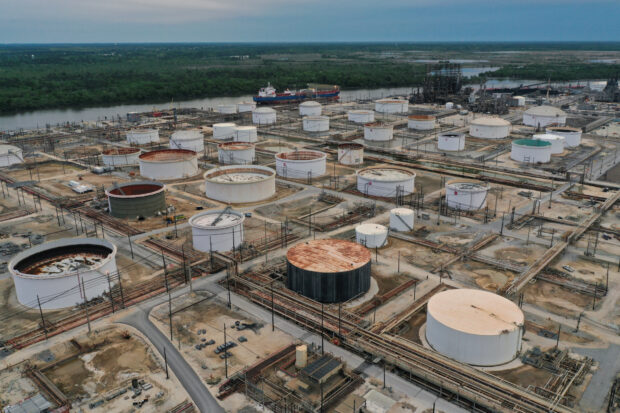
An aerial view of an oil tanker and storage tanks at Exxon Mobil’s Beaumont oil refinery, which produces and packages Mobil 1 synthetic motor oil, in Beaumont, Texas, U.S., March 18, 2023. REUTERS/Bing Guan/File photo
Oil prices held steady in early trading on Friday, but were set for a third straight week of losses after markets witnessed dramatic drops on fears of a weakening U.S. economy and slowing Chinese demand.
Brent crude rose 14 cents, or 0.2 percent, to $72.64 a barrel at 0002 GMT, while U.S. West Texas Intermediate was up 17 cents, or 0.3 percent, at $68.73 a barrel after four straight days of losses.
For the week, Brent was set to close down 8.7 percent, while WTI was set to close 10.5 percent lower.
Worries of a U.S. regional banking crisis persisted, worrying markets further, after PacWest Bancorp said it planned to explore strategic options.
https://business.inquirer.net/399398/pressure-grows-for-regulatory-intervention-as-us-bank-rout-deepens
Oil prices were also hurt by a strengthening dollar after the European Central Bank raised rates on Thursday and signaled the need for more tightening a day after the U.S. Federal Reserve also raised rates.
A stronger greenback makes crude more expensive for buyers holding foreign currency.
However, investors now broadly expect the Fed to pause rate hikes at its June meeting, after the U.S. central bank dropped language that it “anticipates” further rate increases from its policy statement.
In China, factory activity unexpectedly contracted in April as orders fell and poor domestic demand dragged on the sprawling manufacturing sector, imperiling the broader economic outlook for the second quarter.
https://business.inquirer.net/398624/china-factory-activity-unexpectedly-shrank-in-april
Traders are now focused on the release of U.S. employment data for April later in the day, hoping it could help gauge the health of the economy, as well as comments on monetary policy from St. Louis Fed President James Bullard and Minneapolis Fed President Neel Kashkari at the Economic Club of Minnesota.